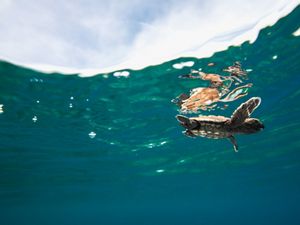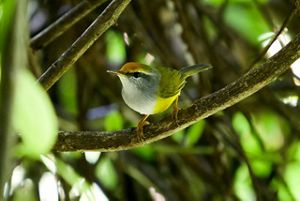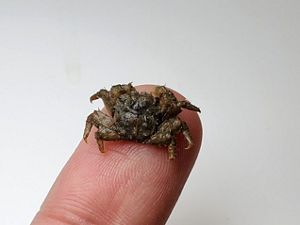Nature is all around us. If we want to survive and thrive, we must commit to co-exist with all the species on Earth. Of all the plants and animals with whom we share the planet, only we have the power to choose the path our collective futures will take.
Biodiversity underpins every aspect of life on our planet—but it's currently declining at an unprecedented rate. And up to one million known species could disappear by 2050.
This is why The Nature Conservancy (TNC) is using targeted, collaborative conservation efforts of lands and oceans to save many important and iconic species in the region at a scale that matters. Whether it’s an orangutan, a sea turtle or a snow leopard, our strategies increasingly protect Asia Pacific wildlife while respecting the needs of the people who call the region home.

Yunnan Golden Monkey - Rhinopithecus bieti
Status: Endangered
The Yunnan golden (or snub-nosed) monkey’s namesake feature comes from the absence of nasal bones—an evolutionary peculiarity of unknown origin. These primates inhabit a sliver of high-altitude, coniferous forest in the Yunling Mountains of southwest China. Here, they amass in bands as large as 300 individuals to forage for their favorite food: lichens. Smaller family groups typically consist of one male with several females and their young. But habitat loss and illegal hunting have strained this species already struggling to survive in isolated and fragmented populations.
TNC is working with partners and local communities to protect Yunnan golden monkeys by: tracking the monkeys’ movements, protecting monkeys’ homes, restoring forest habitat and educating communities.

Hawksbill Turtle - Eretmochelys imbricata
Status: Critically Endangered
The life of a hawksbill sea turtle is one of long odds and improbable journeys. Measuring about three feet in diameter, with a mottled, amber-hued shell, hawksbills take decades to reach reproductive age. Often they migrate well over 1,000 miles — from coral reef foraging grounds, through expanses of open ocean and finally, to the beaches where they once hatched and return to nest, every two to seven years. Very few hatchlings will survive to make this journey on their own. And those that do face many human threats from poaching to fishing vessels capturing them as bycatch.
In the Solomon Islands, home to the South Pacific’s largest hawksbill rookery, TNC helped establish the country’s first national park where 25 years of conservation efforts have increased the number of turtle nests by 200 percent.
Test your knowledge of hawksbills and learn what you can do to save them.

Chinese Pangolin - Manis pentadactyla
Status: Critically Endangered
Pangolins are known as the guardians of the forest because they protect forests from termite destruction, maintaining a balanced ecosystem. They have survived thousands of years of natural changes, but now they are on the verge of extinction due to habitat loss and illegal poaching. More than 1 million pangolins were brutally murdered for black-market trade in the past 10 years; that is 11 pangolins every hour. Many Asian cultures incorrectly believe pangolin scales have medicinal and magical properties, causing a huge demand on the black market. Pangolins are the world’s only scaly mammals.
TNC is working with local and international partners to raise public awareness on saving pangolins and fighting against their illegal trade.

Eastern Curlew - Numenius madagascariensis
Status: Endangered
The largest of all the world’s shorebirds, the Eastern Curlew’s impressive bill is used to probe mud and dig up crabs and molluscs which is their main food source in Australia. Sadly, they’re endangered and have declined by more than 80 percent in the past 50 years. The Eastern Curlew takes an annual migratory flight to Russia and north-eastern China to breed, arriving back home to Australia to fatten up before the long journey up north again to breed.
The Eastern Curlew is declining as a result of habitat destruction and alteration to the chain of coastal wetlands along their migratory path. The loss of even small areas of wetland can be devastating, which is why TNC is protecting and restoring wetlands in Australia and around the world.
Subscribe to our email updates
Get timely conservation news to get involved and make a difference.
Subscribe Now
Asian Elephant - Elephas maximus
Status: Endangered
For centuries, the timber industry in Myanmar (formerly Burma) has relied on Asian domesticated elephants for hauling teak and other valuable hardwood from forest to market. These animals represent one of the world’s best reduced-impact logging strategies, limiting the need for extensive logging roads, bulldozers or mechanized tools. And despite their vigorous labor, Myanmar timber elephants live twice as long as zoo elephants and are extraordinarily well-cared for: Each animal is given a mahout, or caretaker, who is devoted to the health and well-being of the elephant for its entire life. However, Myanmar’s elephants—both domesticated and wild—face myriad threats to their survival, such as shrinking habitat, poaching and the threat of being sold into the tourism industry in neighboring Thailand.
TNC is working to improve animal welfare for timber elephants, protect forest habitat, provide needed alternative livelihoods for communities through ecotourism and promote research on timber elephants’ contribution to a unique, low-carbon pathway for Myanmar.

Bornean Orangutan - Pongo pygmaeus
Status: Critically Endangered
Orangutans are among the rarest primates on Earth. Faced with deforestation, poaching, the illegal pet trade and forest fires, orangutan populations have reached a critical point. Since 1960, their populations have declined by 50 percent. Orangutans help forest health by acting as the world’s largest seed dispersers. Because they cover large areas as they forage for food, fragmented habitat is an additional risk. They spend most of their time in trees. That’s where they thrive.
TNC has a holistic approach to forest conservation in Indonesia including working with the local communities who live in forests, and we partner with government and industry to change policies and practices to protect the third-largest tropical rainforest on the planet.

Snow Leopard - Panthera uncia
Status: Vulnerable
Snow leopards are one of Asia’s most iconic species — and also one of the most elusive. These beautiful, secretive big cats inhabit a broad expanse of the continent’s high-altitude environments, but only number between 4,000 to 6,500 — a 20 percent decline in the past two decades, primarily due to human-wildlife conflict and habitat loss. Mongolia is a snow leopard stronghold, home to as much as one quarter of the global population.
With a decade of experience in Mongolia, TNC is working with herders to strengthen local grassland and grazing management. As grazing improves, we can reduce direct conflict between snow leopards and herders, as well as improve habitat for wild prey species that are important to snow leopards.

Yellow-Eyed Penguin - Megadyptes antipodes
Status: Endangered
In Aotearoa New Zealand, lives the world’s rarest penguin species, the yellow-eyed penguin. Yellow-eyed penguins have suffered a dramatic decline in population, with an estimated 2,000 alive today. By comparison, they numbered about 6,000 only a decade ago. The reason why is a mix of human interference and an insidious disease. With a rising global demand for New Zealand’s dairy, cattle and sheep have driven the destruction of the penguin’s habitat to make way for agriculture and pastures.
We’re collaborating with industry, local conservation groups and government ministries to find much-needed solutions to protect terrestrial and marine habitats upon which penguins and other wonderful species depend.



